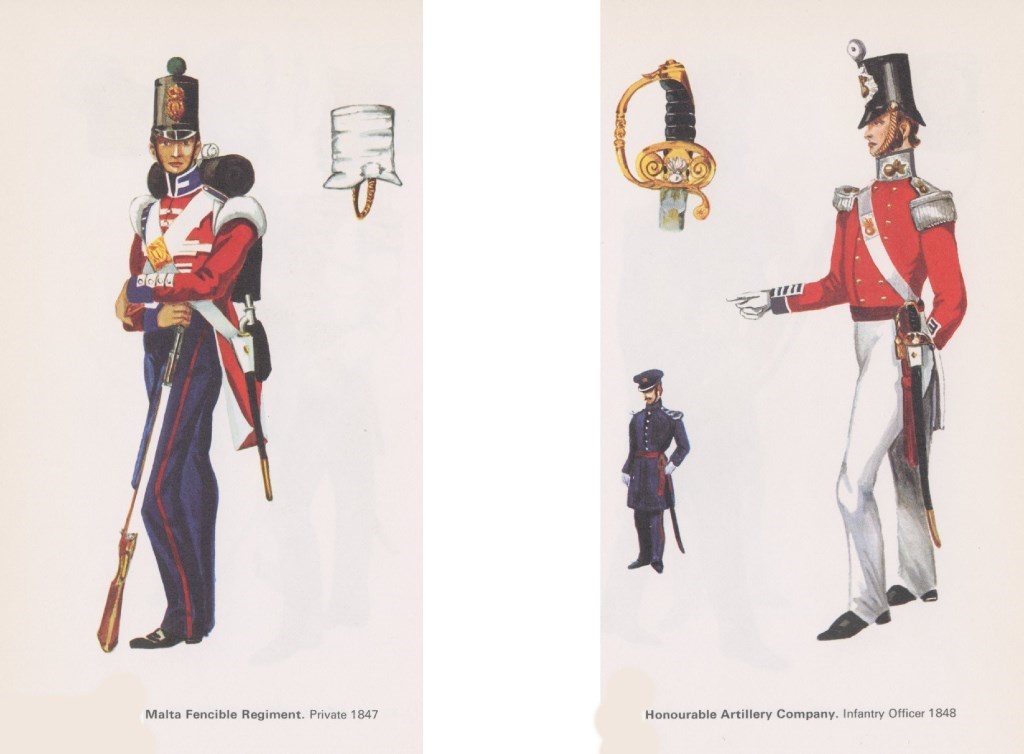
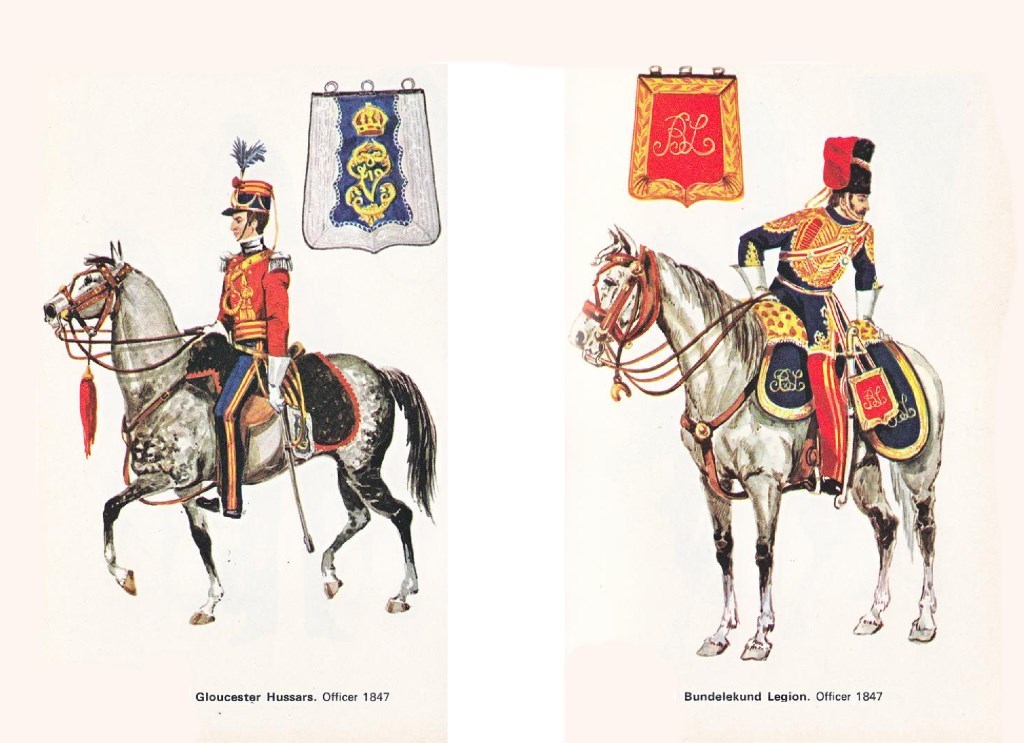
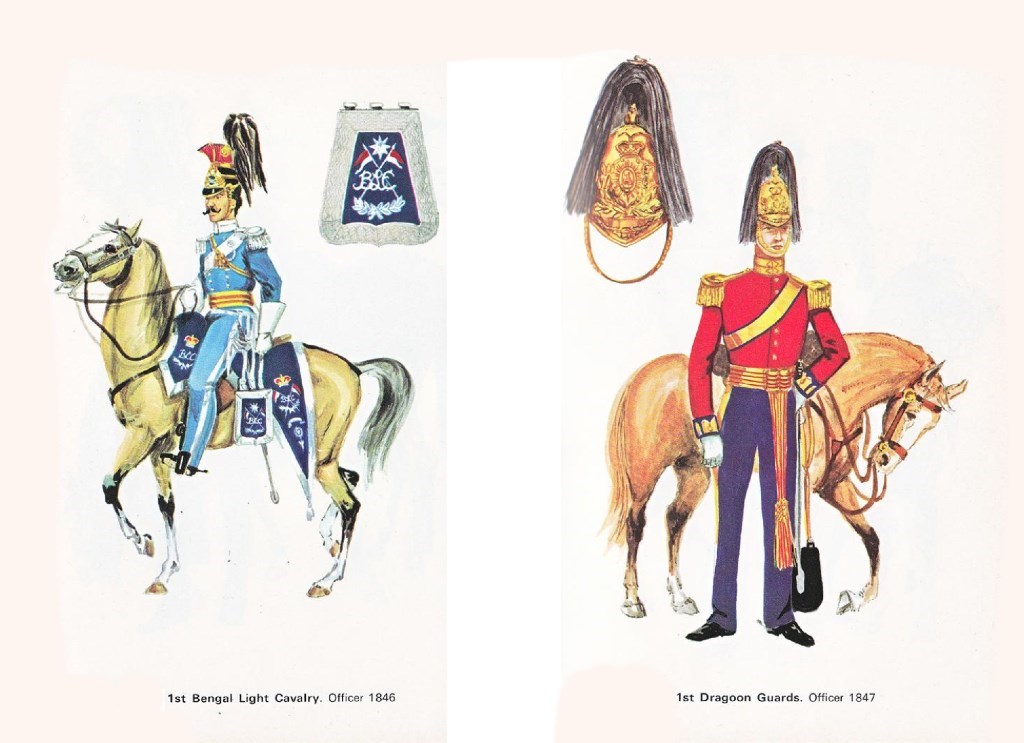
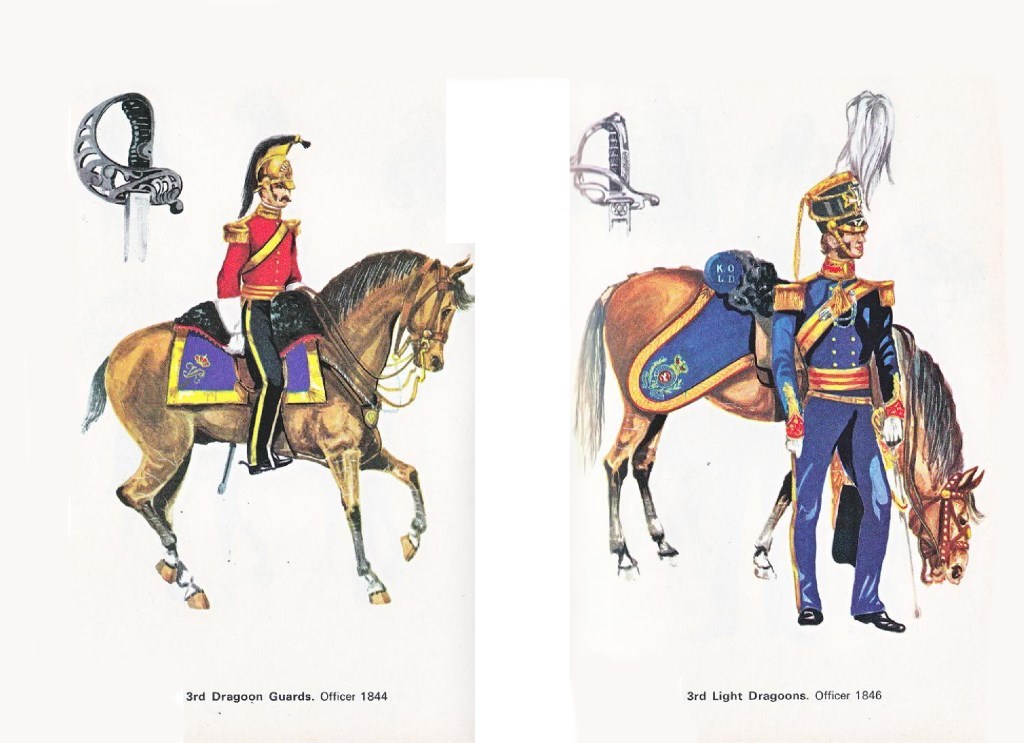

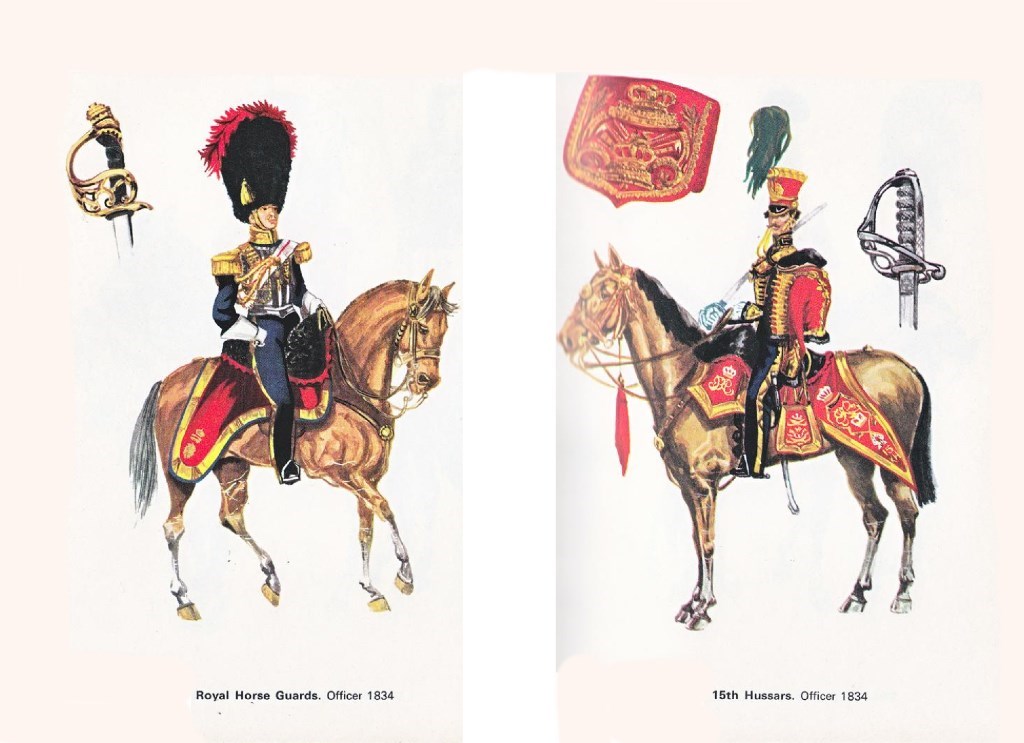
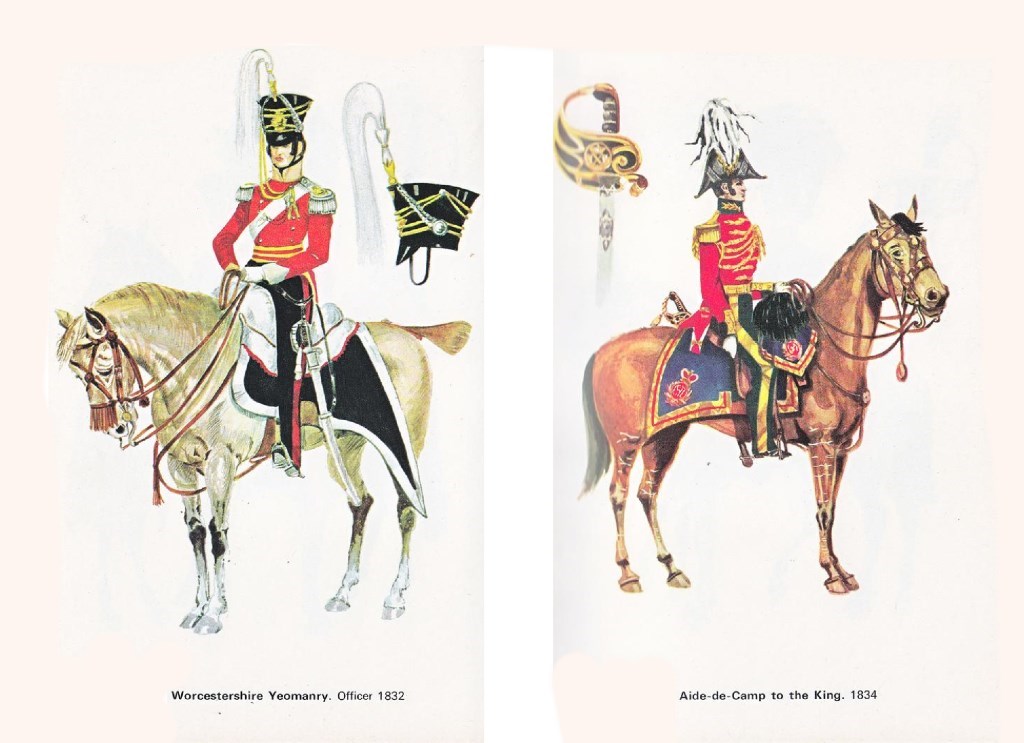
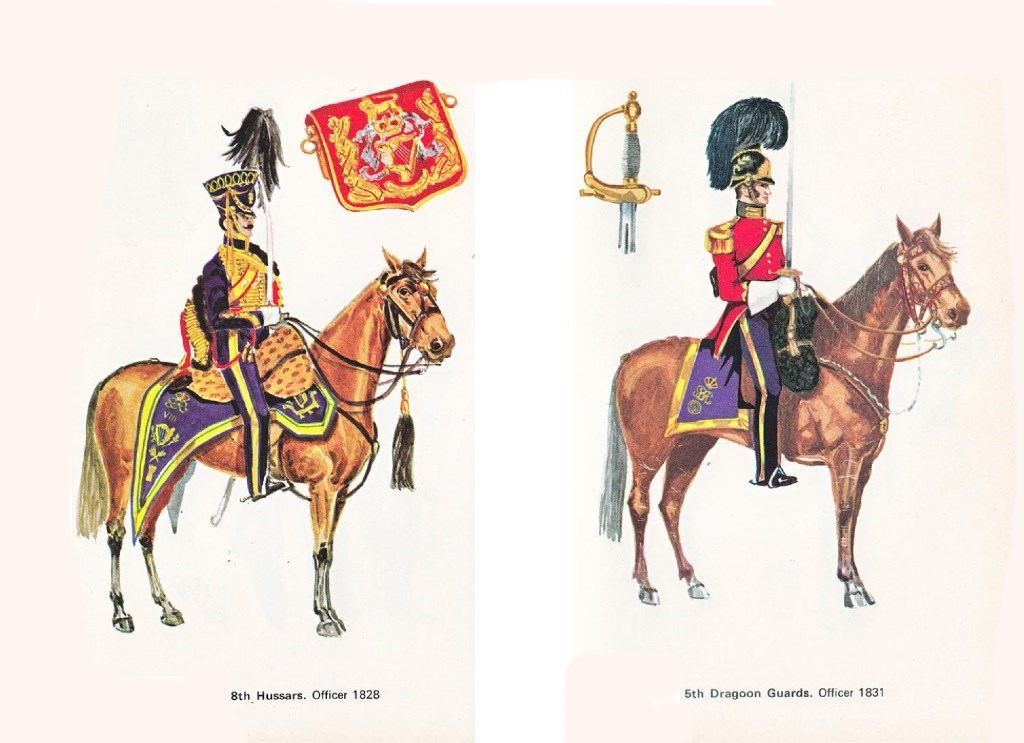
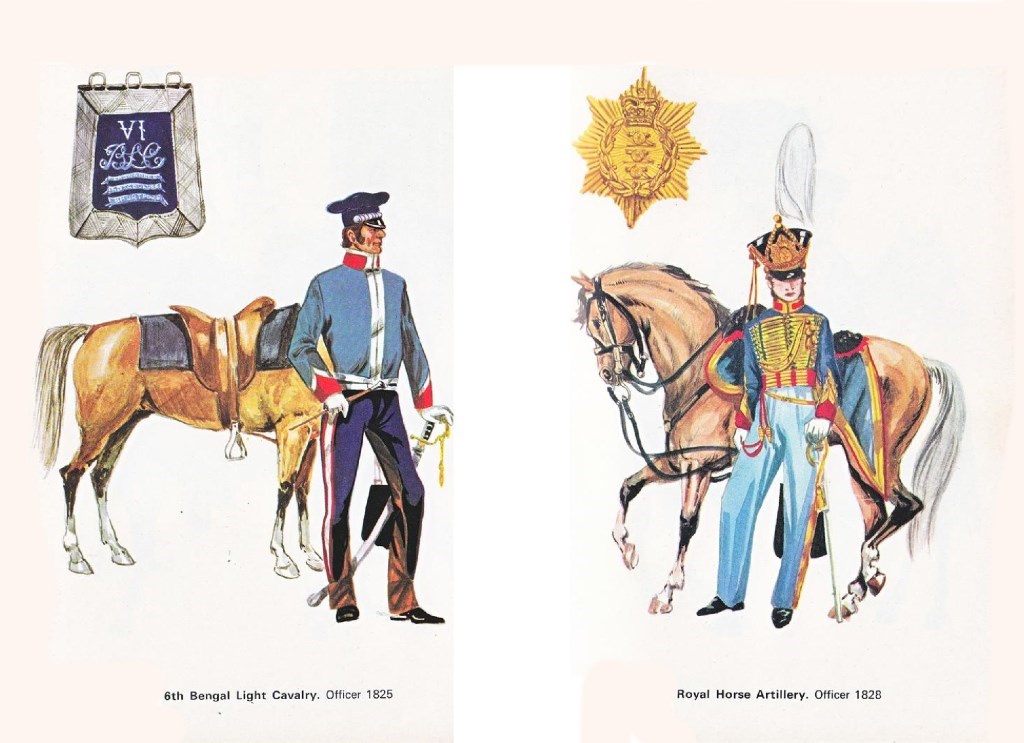
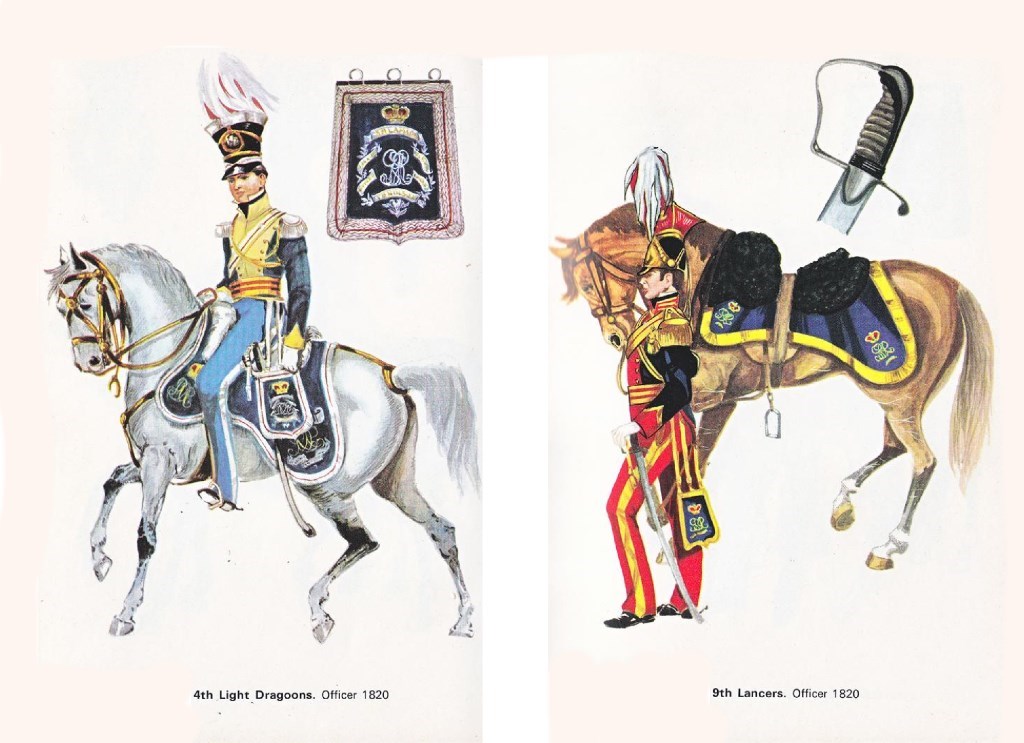
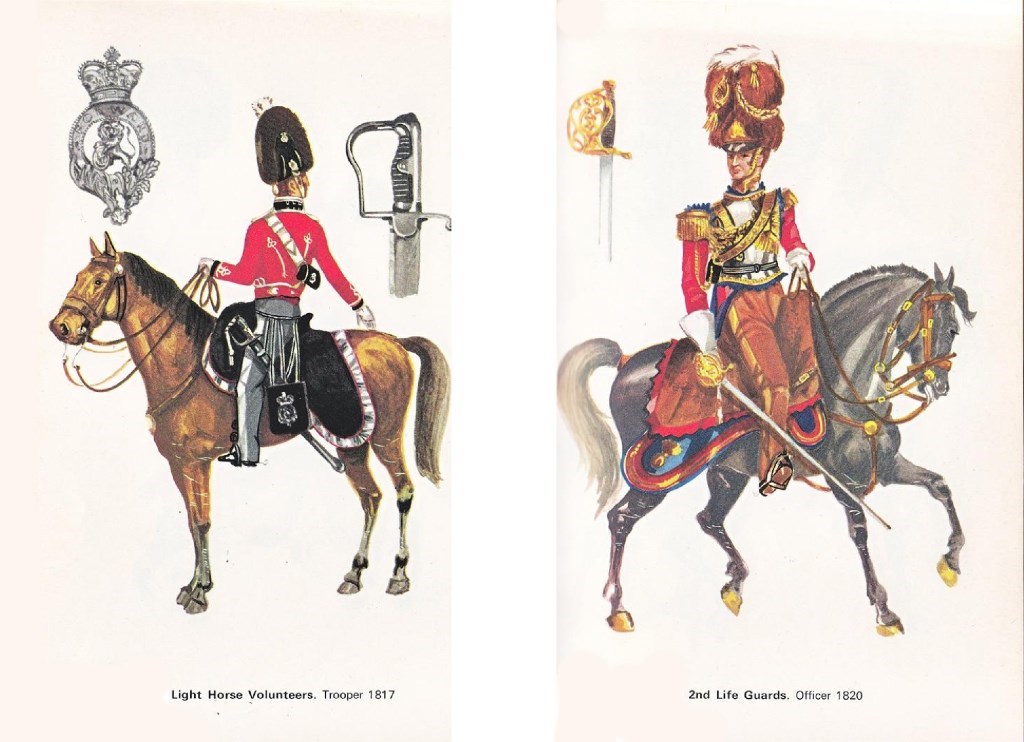
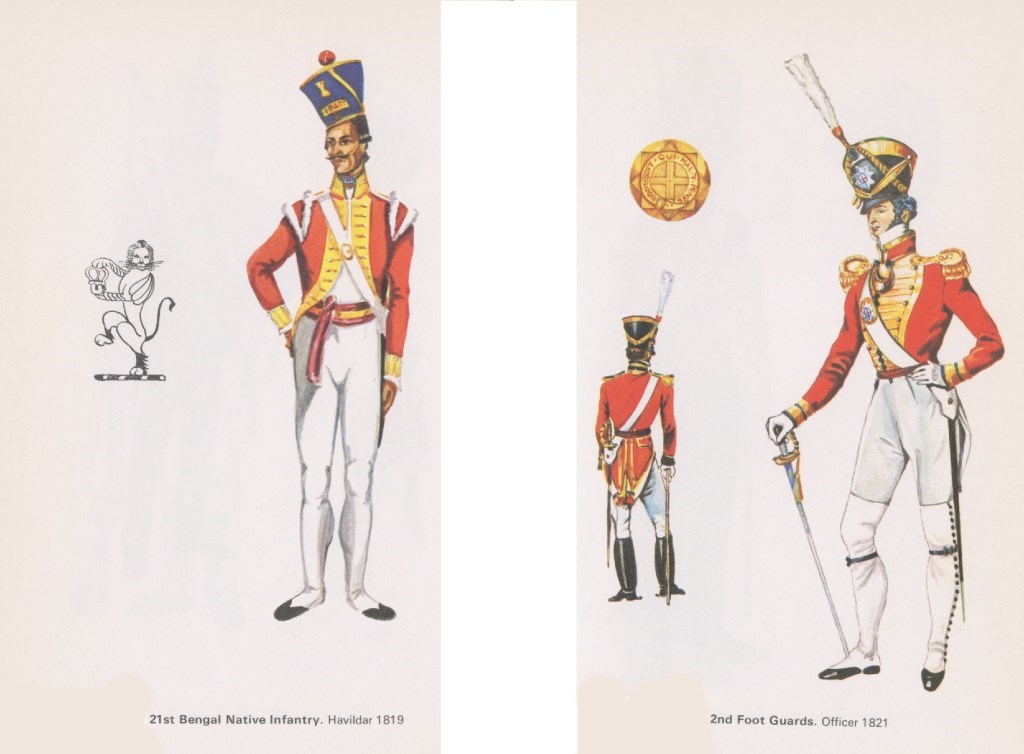
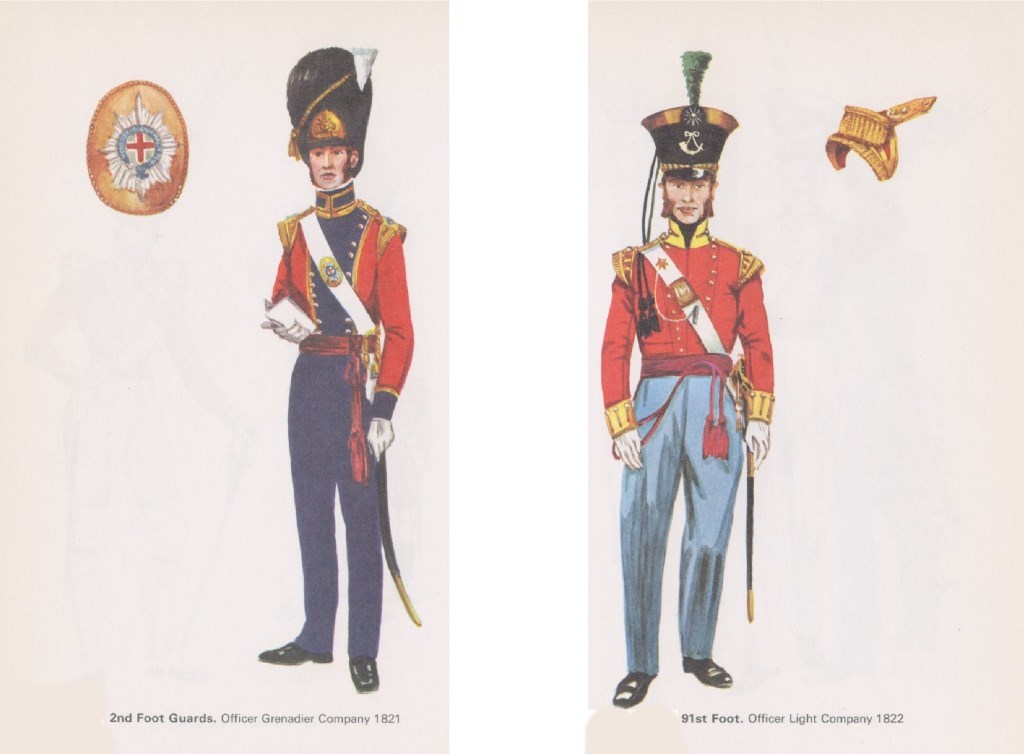
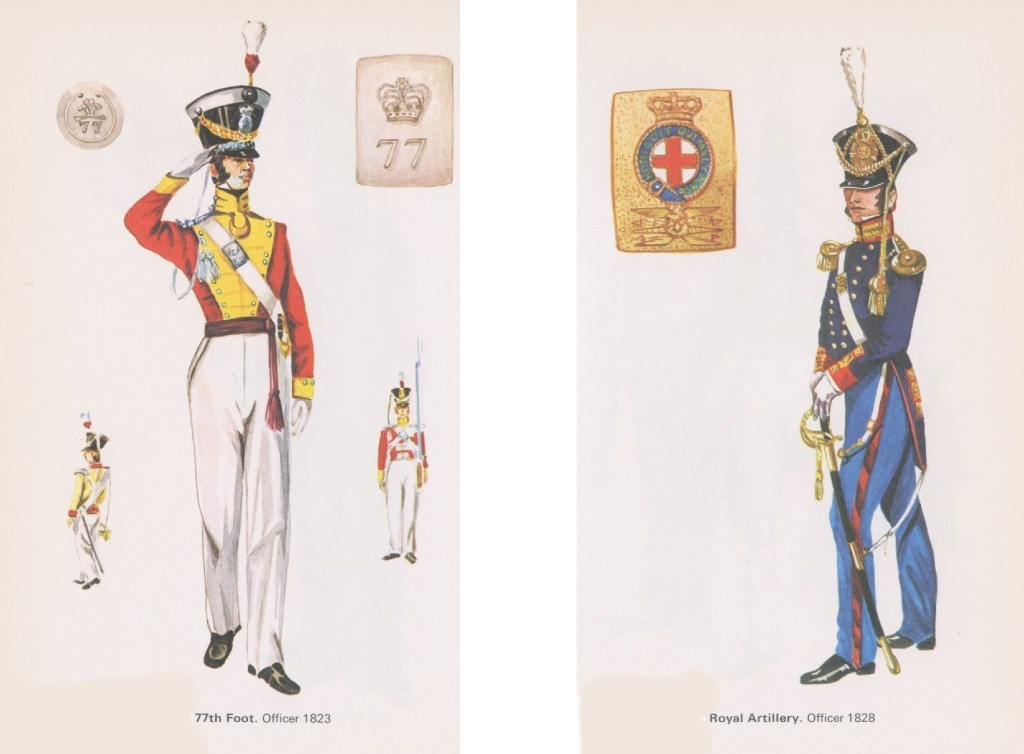
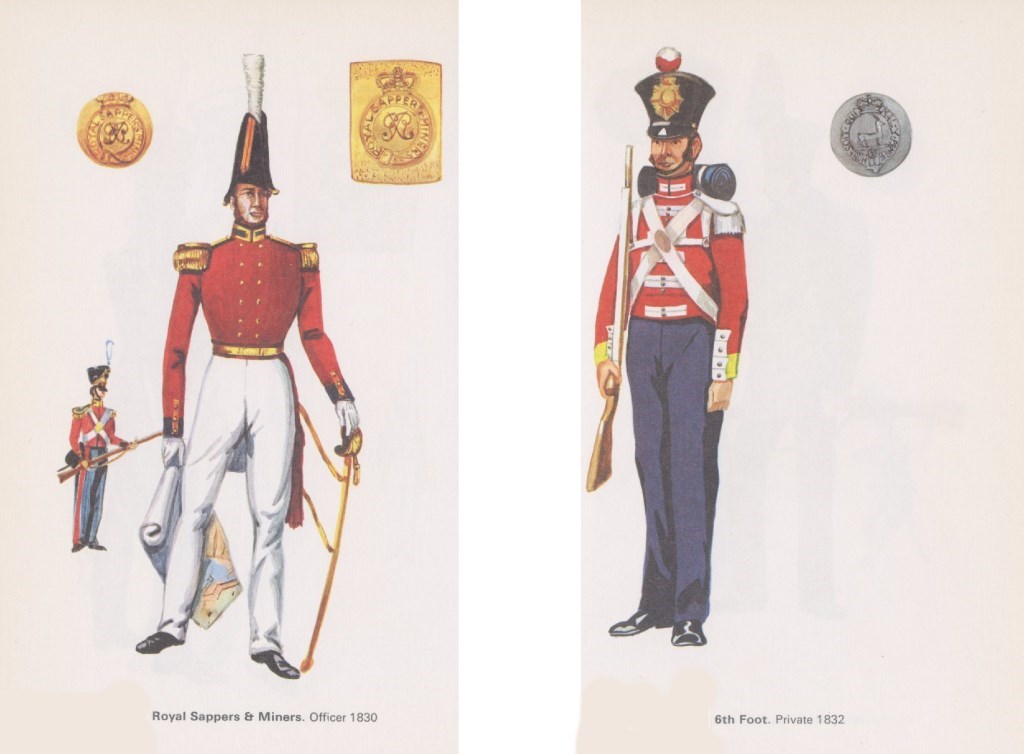
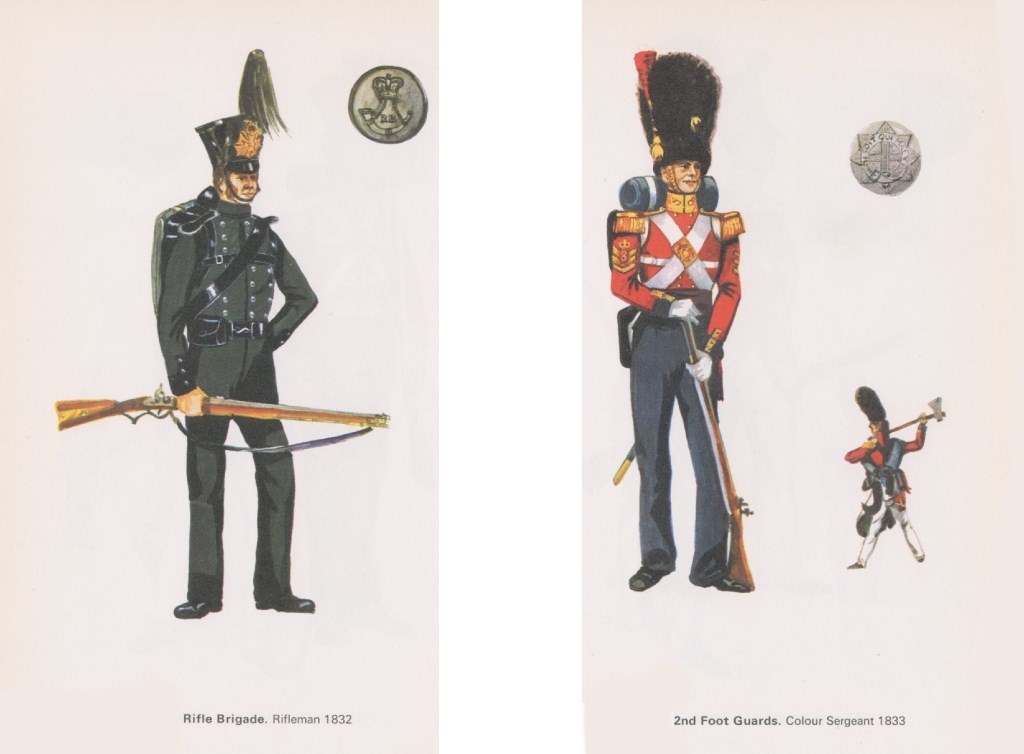
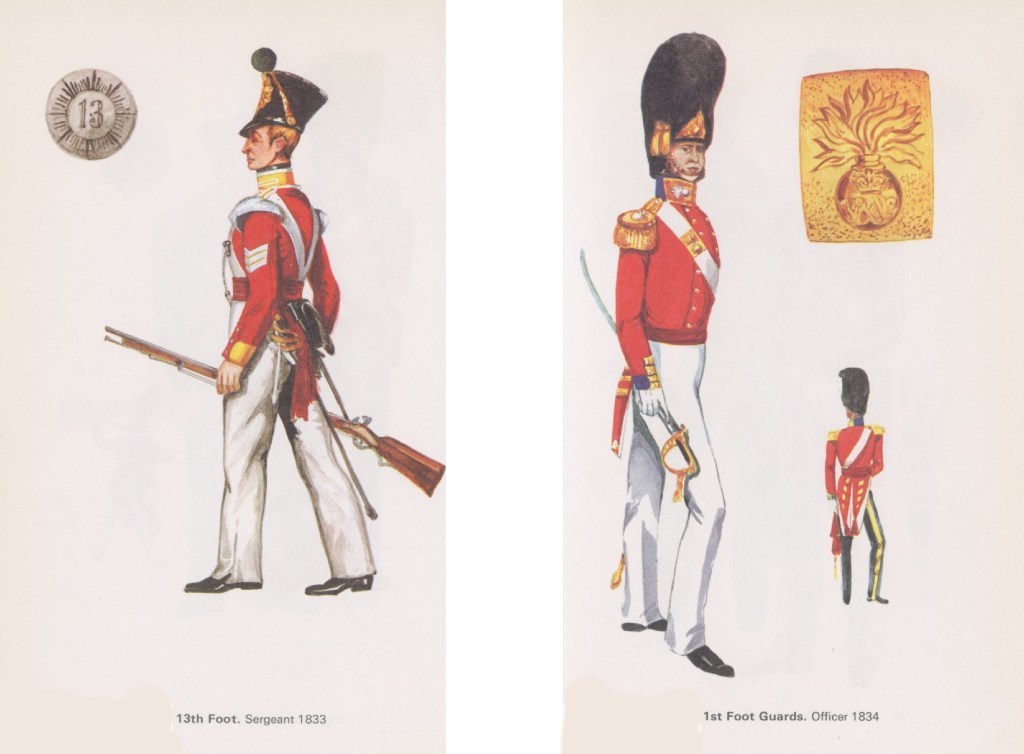
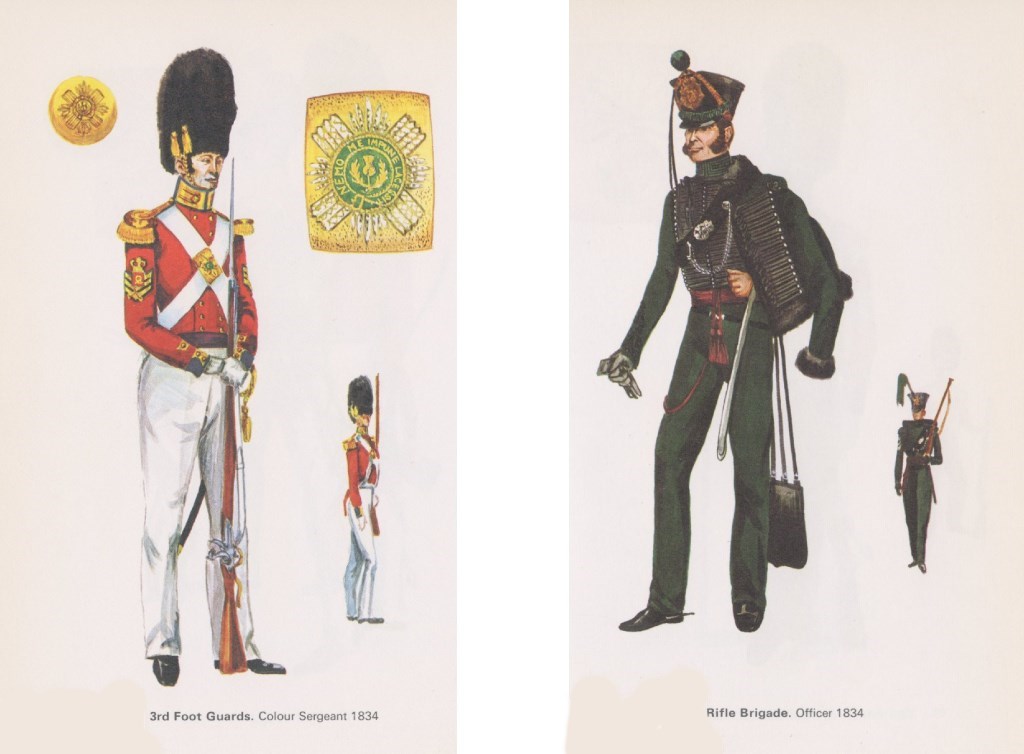
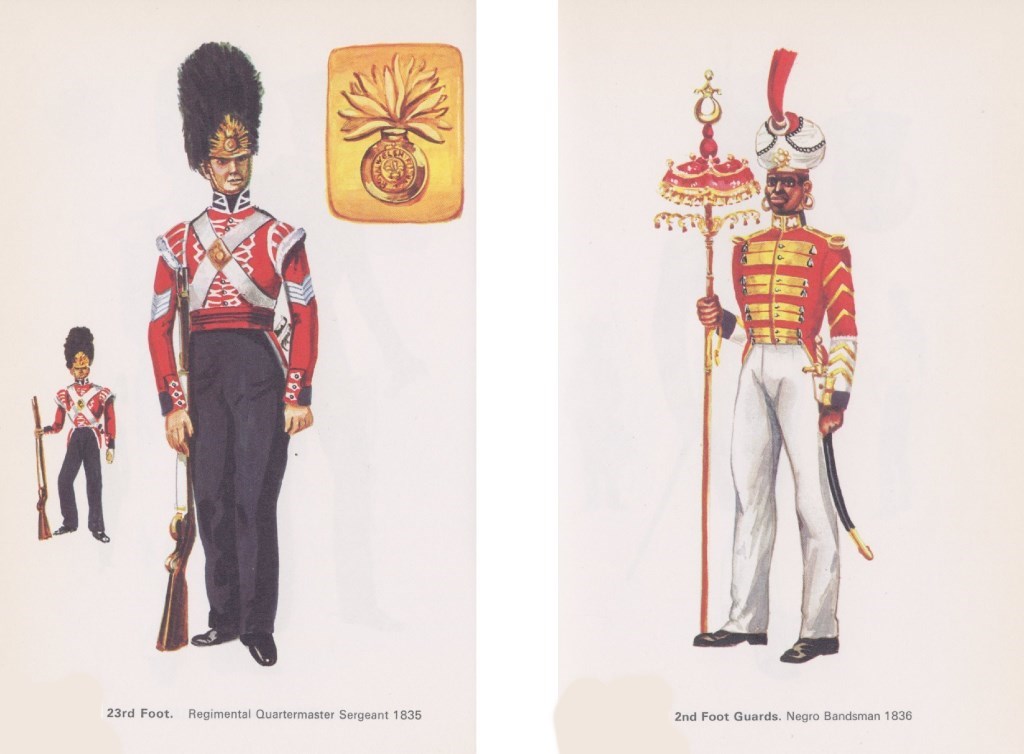
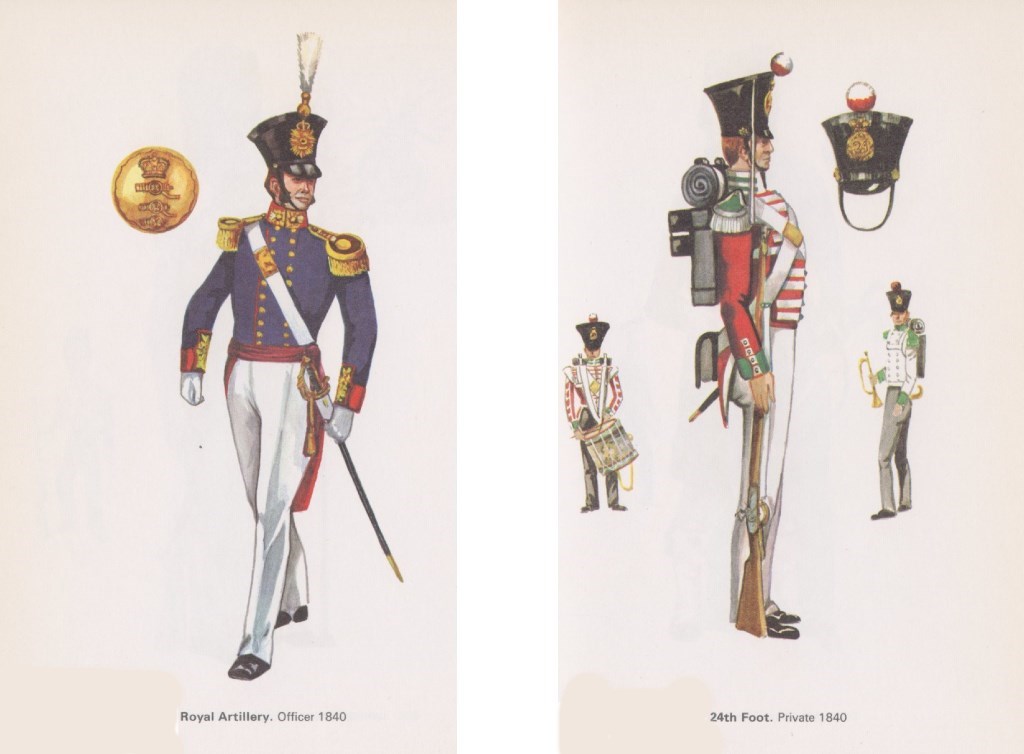
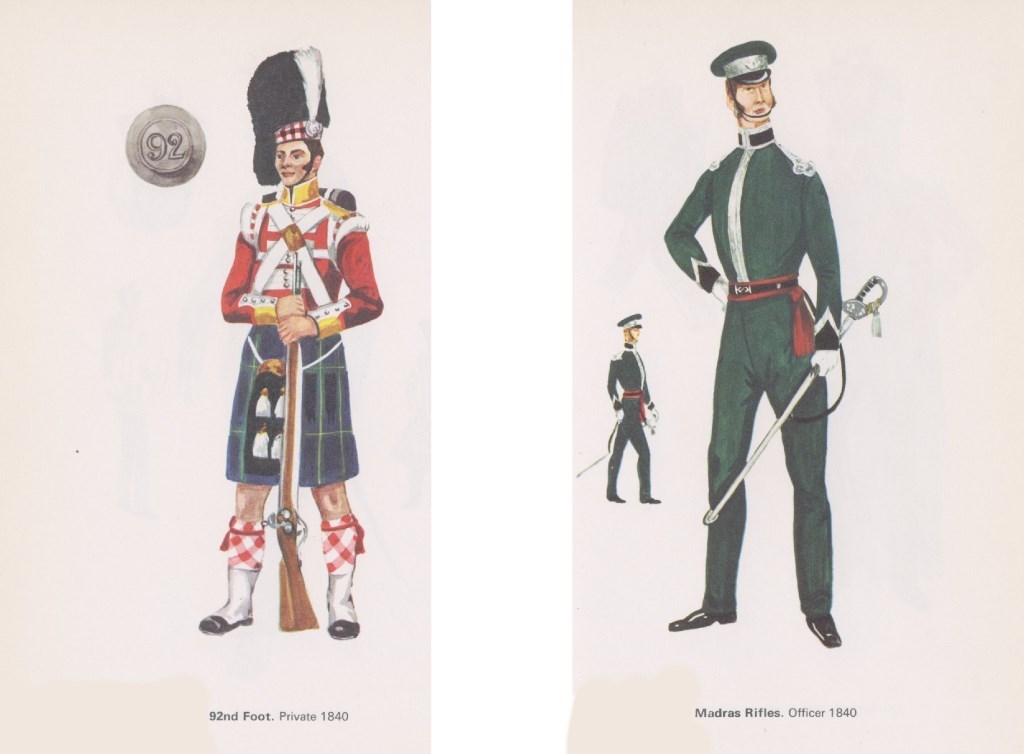
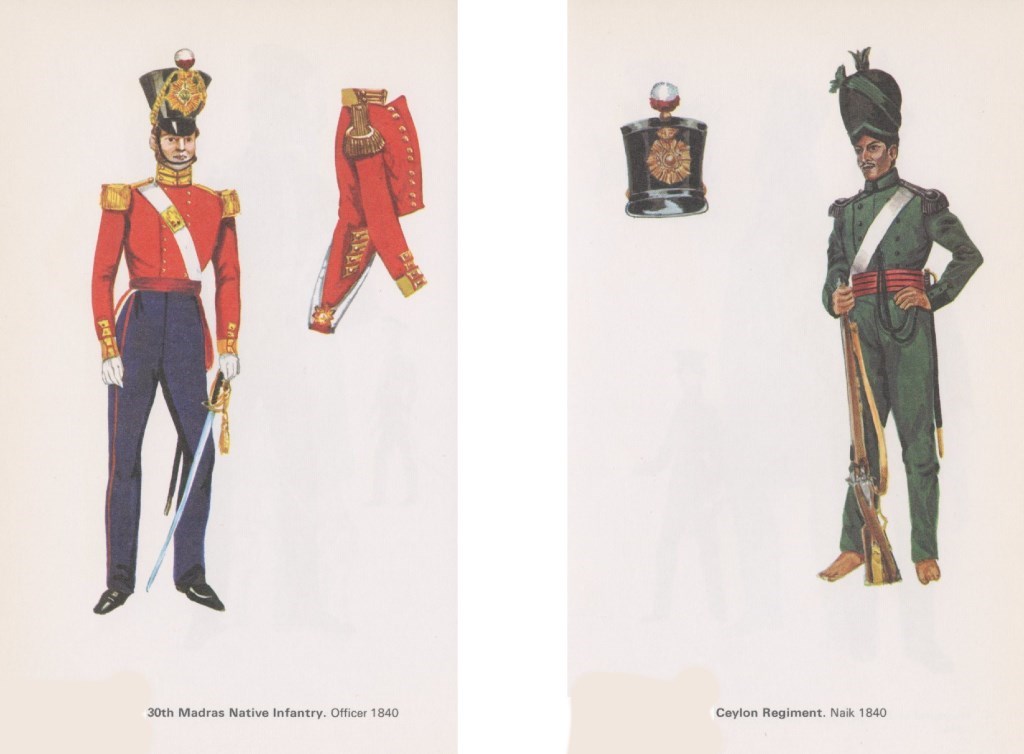
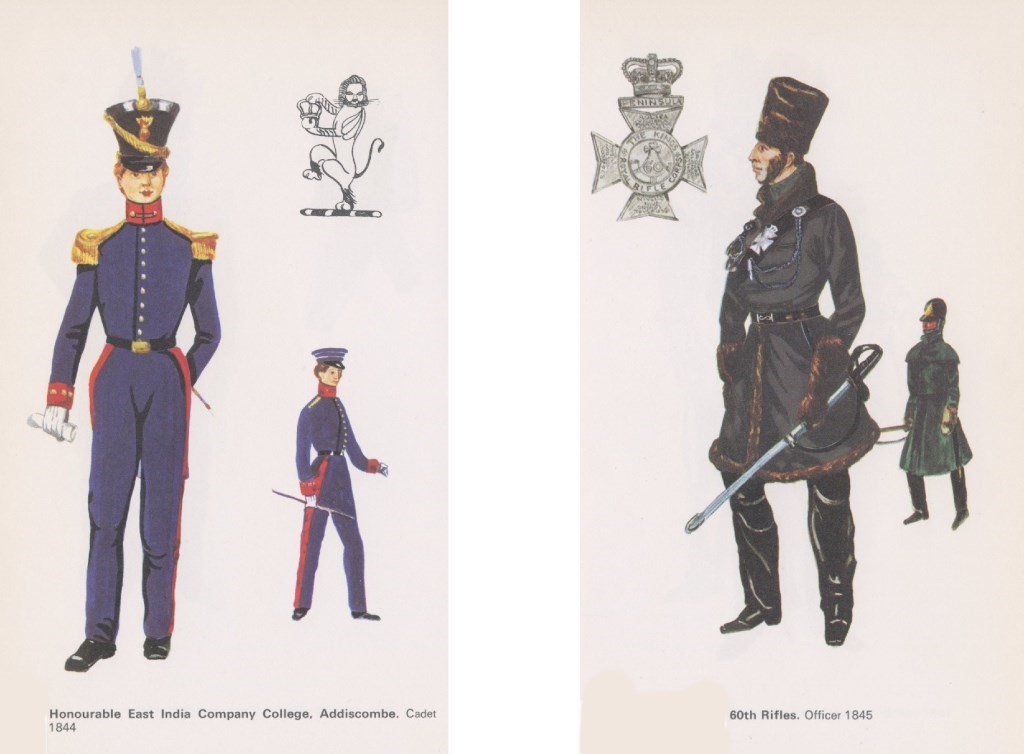
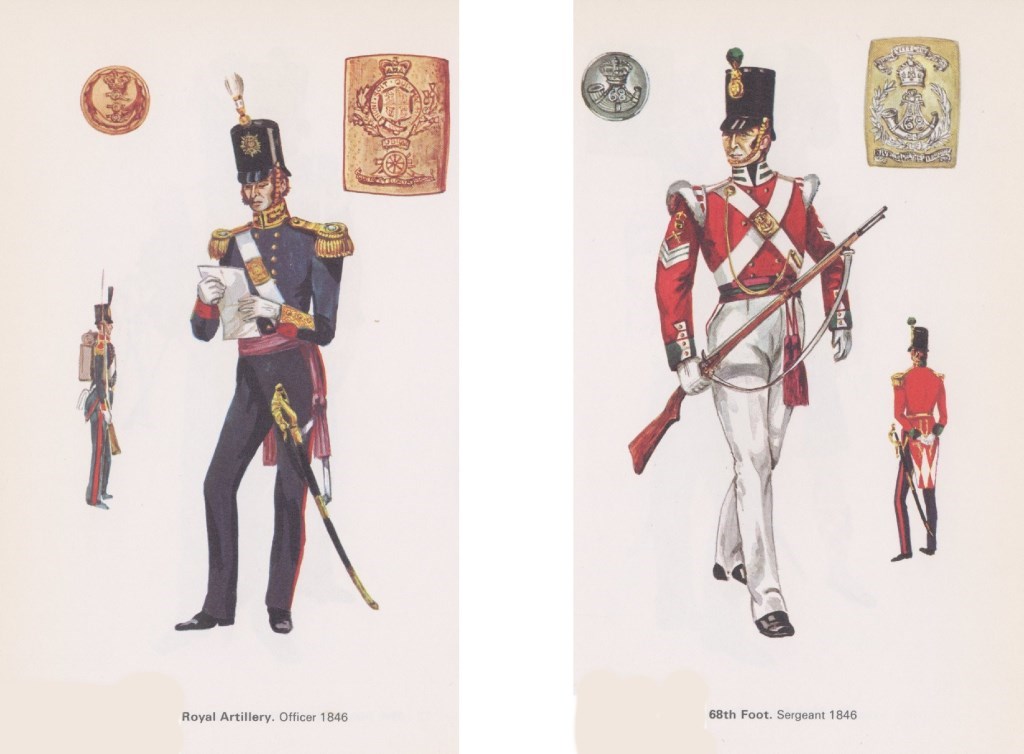
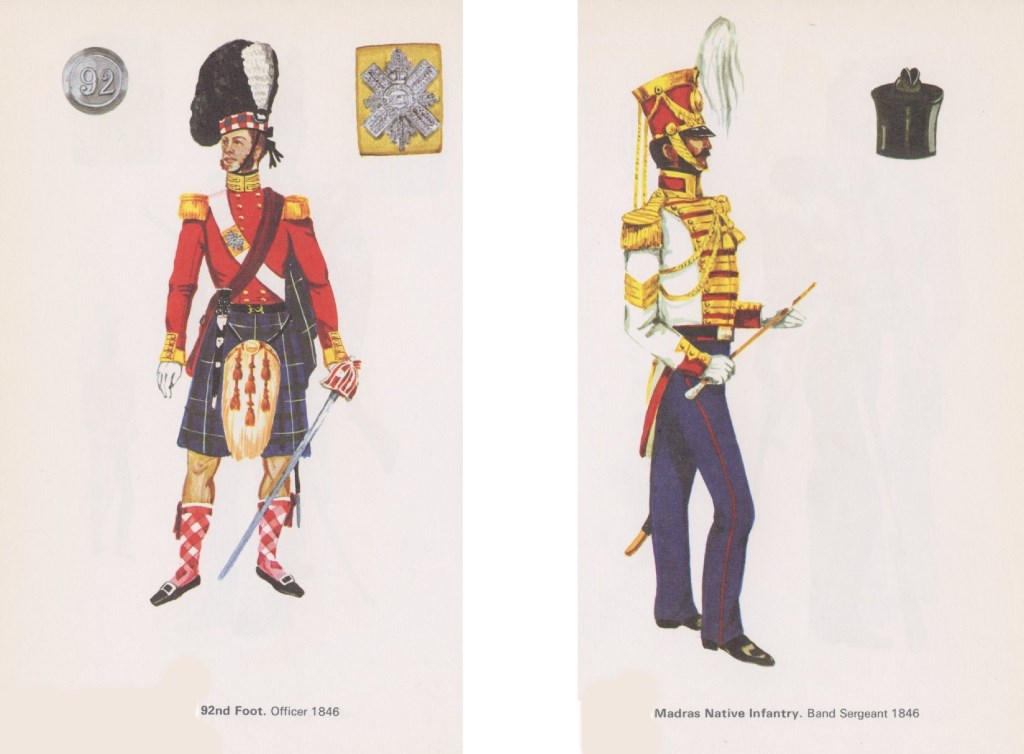
First Ashanti War 1823–1831
First Anglo-Burmese War 1824–1826
First Anglo-Afghan War 1839–1842
First Opium War 1839–1842
First Anglo Marri War 1840
First Anglo-Sikh War 1845–1846
REVOLUTIONARY DEVELOPMENTS IN EQUIPMENT
The large city of Bhurtpore was stormed by an army which relied wholly on smoothbore flintlock weapons and, on the face of it, there was little advance in arms in the quarter-century which followed Waterloo. Beneath the surface, however, inventions were maturing which would change the whole face of land warfare. Since the early years of the eighteenth century it had been known that certain forms of explosive could be detonated by percussion, by striking it a sharp blow. No military use of this principle was made until 1805 when the Reverend Alexander Forsythe, the minister of Belhelvie and a keen wild-fowler, devised a compound of fulminate of mercury and chloride of potash, which he enclosed in a metal tube provided with a touchhole just large enough to admit the point of a cambric needle, which was, in tum, struck by a hammer. He found this device far more efficient for setting off the propellant charge of his fowling piece than a flintlock which was much affected by the mists of his native Aberdeenshire. He took his invention to London where friends introduced him to Lord Moira, Master General of the Ordnance. Moira was impressed and installed him in a laboratory in the Tower of London where considerable progress was made until, on a change of government, the indolent Lord Chatham became Master General and turned Forsythe and ‘all his rubbish’ out of the Tower. That was in 1807, the year in which Forsythe patented a percussion lock which soon became popular with sportsmen. No military use was made of the invention for the next twenty-seven years, by which time similar devices had been made in Britain, France, and the United States.
In 1834, at last, the Board of Ordnance again took an interest. Trials were held at ‘Woolwich at which six percussion muskets were tried against six standard flintlocks. The result was overwhelming. The percussion type was found to be twenty-six times more reliable and, after the Duke of Wellington had made his own exhaustive tests with his own sporting guns, orders were given for all British muskets to be converted to percussion, a change completed in 1842. Forsythe was given a grant of £200 but the extraordinary meanness of this award raised a public outcry and a pension of £1,000 was added. The first instalment of this was paid on II June 1843, the day on which he died. The introduction of the percussion cap greatly increased the reliability of the musket, reducing the number of misfires from two in thirteen to almost nil. It did nothing to increase the rate of fire, indeed it may have slowed it down while the soldier fumbled for the little cap in his pouch. Nor did it do anything to increase the range of the musket. This could only be done by introducing rifling and, as long as muzzle-loading weapons remained standard, the problem remained of how to force the ball down the barrel. In France, Captain Delvigne in 1826 had designed a musket which, at the rear end of the barrel, had a chamber of smaller calibre which was filled with powder. The ball was rolled down the barrel until it rested on the shoulders of this chamber and then tapped sharply with the ramrod. Being of lead it was expanded by the tapping so that it now fitted into the rifling grooves. Delvigne rifles were issued to a battalion of Chasseurs d’Afrique in 1838. At about the same time the British were also issuing a new weapon to the Rifle Brigade. This was the Brunswick rifle which had only two rifling grooves which made one turn in the length of the barrel (30 inches). The ball was equipped with a belt which fitted into the grooves, enabling it to be spun down the barrel. The Brunswick was as accurate at 300 yards as its predecessor, the Baker, was at 200 but it was unpopular with the Riflemen. It was two pounds heavier than the Baker and fouling in the grooves soon made it very difficult to load especially as the belt on the ball was often damaged in the pouch. It was, however, the first percussion weapon issued to any army.
As armies began to struggle free from the limitations imposed by the flintlock musket, they were beginning to break out of the stranglehold on mobility imposed by the pace of the marching infantry and the plodding pace of the supply waggon. In 1829 the railway from Stockton to Darlington was opened and in the following year a battalion was moved from Liverpool to Manchester on a newly-opened line. The journey took two hours compared to the two days by marching.
Britain pioneered the railway but, being an island, she gave little thought to strategic lines. It was Prussia, exposed to attack from France on the west, Austria on the south, and Russia to the east, to whom strategic railways made the strongest appeal. Early in the thirties Dr F. W. Harkort, a Westphalian business man, was urging that lines should be built with war in mind. ‘Let us suppose that we had a railway and a telegraph line on the right bank of the Rhine from Mainz to Wesel. Any crossing of the Rhine would then scarcely be possible since we would be able to bring a strong defensive force to the spot before an attack could develop.’ Despite strong military opposition which, as late as 1847, contended that horses and guns could not be moved by train, Prussia did develop an unrivalled network of strategic railways.
France also saw the importance of railways but regarded them principally as a way of saving money. In 1833 M. de Berigny told the Chamber of Deputies, ‘An army could, in a few days, be transported from the north to the south, from the east to the west. If a country could thus speedily carry considerable masses of troops to any given point, would it not be in a position to effect great economies in its military expenditure?’
Meanwhile military thought was being stirred by two men who attempted to distil their experience as staff officers in the Napoleonic wars. Karl von Clausewitz, a Prussian who had joined the Russian army when his own country became Napoleon’s ally, died before his great work On War was completed, but it was issued, as far as it was written, by his widow in 1832. Clausewitz put his main stress on the psychological factors in war and was best remembered for his dictum: ‘To introduce into the philosophy of war a principle of moderation would be an absurdity … War is an act of violence pushed to its utmost bounds.’ Had he lived it seems probable that he might have modified this advocacy of total war and it is certain that strategists would have done better to lay more stress on another of his sayings: ‘There is no more imperative and no simpler law of strategy than to keep the army concentrated’. This maxim was made much more feasible by the coming of the railways, which Clausewitz did not live to see.
Henri Jomini, a Swiss, had also served with the Russian army but his previous experience had been on the other side, as chief of staff to Marshal Ney. His Precis de !’Art de fa Guerre was published in 1838 and, like Clausewitz; he laid great stress on concentration. His most memorable passages are those in which he advocates ‘manoeuvring in such a manner as to engage the mass of one’s own force against only fractions of the enemy’s armies … directing this mass successively on the decisive points of a theatre of war and, as far as possible, on the enemy’s communications without endangering one’s own’. Here Jomini formulated what came to be known as the ‘strategy of the indirect approach’ but, even with the coming of the railway, tactical mobility was still controlled by the pace of the man and the horse. It is doubtful whether Jomini’s teaching, which tended to reduce war to a series of geometrical manoeuvres, was of much practical value until, in the twentieth century, the internal combustion engine brought tactical mobility to the battlefield.
#
The first fifty years of the 19th century furthered the paradox of the anti-intellectual, hedonistic, sport-loving gentleman regimental officer again generally displaying robustness, initiative and personal bravery when needed. At first sight, the period appears to be one of stagnation. It was, however, especially for the infantry, a period of almost continuous colonial campaigning that taught flexibility and improvisation and wrought, inconspicuous beneath the surface, a small number of changes and formative developments to bear fruit later.
The absence of any likely major Continental European enemy led once more to demands for a peace dividend. Reductions of the Army from its 1816 strength of 149,000 to 100,000 by 1821 followed. Thirty-five infantry and eight cavalry regiments were disbanded. The demands of Indian and colonial operations, however, led to small increases in the 1830s, by 1837 to 109,000. Except for the excess and untypical behaviour of a few officers, notably the Earl of Cardigan in his command of two cavalry regiments, the general public and press was little interested in the Army. In addition, many of the soldiers, including those in regiments linked to midland and southern England, were Irish, adding to English indifference. The popular support, so evident in the 1812-15 years, had evaporated very quickly.
In military journals and elsewhere debate and discussion did take place. Some officers argued for a common training for all infantry regiments but with differing ideas as to what that training should be; others argued for more light infantry and rifle units. The infantry welcomed the percussion-cap musket, introduced from 1838 onwards, but opinion did not favour the issue of the Baker rifle to line regiments. The merits and tactical possibilities of the Minié rifle, which was authorised for all infantry in 1851, had not been fully appreciated by the outbreak of the Crimean War and one Division had not even been issued with it. For the cavalry, argument revolved around the question of the lance or sword, the chances of success for charges against squares, and the wider issue of how important cavalry actually was in any case. Artillery debate centred on the combat deployments and numbers of guns, horses and men, the sizes of guns and the merits or demerits of rockets, mortars and shrapnel, and whether a separate Royal Horse Artillery was necessary. The impact of these debates on academic issues among regimental officers was virtually nil. In practice, officers and NCOs trained their regiments for most of this period at single-unit level only, and in very old-fashioned and very complex drill evolutions modified only a little by Peninsula experience. Training centred on marching in columns on alignment at various distances, the officer keeping the distances accurately, deployment of close column into line, wheeling a close column, echelon marching of divisions into line and formation of a square from column. While district commands existed, no operational command division or brigade structures were created. Nor could the very varied internal security commitments in Britain or the even more varied types of overseas operations provide any general doctrine. In some regiments the colonial or Indian experience of officers, in particular application of tactics to terrain, was even denigrated. The reasons for this would seem to have been primarily social, such experience having been gained by officers obliged to live on their pay; tactlessness from officers with Indian experience may also have played a part. The few officers promoted from the ranks were not thought to have any particular experience or understanding of soldiers that might be valuable. In the event, the post-1815 infantry included an initial six, later eight, light infantry regiments and two rifle regiments each of two battalions. In ordinary line regiments one flank company was to be of light infantry, the other flank company being grenadier, though now with no particular role.
When the Minié rifle was introduced all regiments were finally organised on a common basis and given numbers or alphabet letters, `No. 1 Company’ or `A Company’; light and grenadier companies retained only symbolic significance and, except in the matter of their green uniforms and social cachet, the rifle and light infantry regiments lost their distinctive structure. Regiments varied slightly in the number of companies, the average generally being six companies available for service and between four and one remaining as depot companies, the nucleus if necessary of a second battalion. Company strengths rose to between seventy-five and ninety men. A system of rotation, three years in the Mediterranean, three in the West Indies and three in North America before a home tour, was instituted in 1837 but service requirements occasioned many exceptions.
In the cavalry, four Light Dragoon regiments were converted into Lancers, a distinction being drawn between heavy sword cavalry (Dragoons and Hussars) and light cavalry (Lancers), and regiments were now reduced to a paper establishment of six squadrons each of two troops. Many regiments, however, were in practice composed only of two or three squadrons each of one or two troops, though each squadron now had a second cornet for troop command. The squadron now was often the operational sub-unit. The distinction between heavy and light cavalry was never very clear. Both were to train for the charge, but with light cavalry trained also for reconnaissance and outpost duties. The complex sequence of orders to be issued by officers was slightly reduced but still included twenty-one field evolutions covering space, keeping in line, advancing and retiring, heading and flanking military columns on the march, picquet guards for camps and patrolling. On operations or on the march, the squadron commander and the two troop leaders rode in front while the two or three very junior officers followed behind the rear file.
For a charge, officers would dress the regiment by squadrons, half-squadrons (troops), divisions (half-troops) and sub-divisions (quarter-troops) in one or two lines (the second being an immediate reserve) and order successively `Trot’, `Gallop’ and `Charge’ as the pace increased. After the charge, officers were to retire in columns of troops on each flank and reform behind the rear line. Officers on joining regiments were instructed in sword drill and the correct `military seat’ on horseback. Heavy cavalry was not sent to India in the first half of the century; when a light cavalry regiment was sent its strength would be increased by as much as 25 per cent, an increase that led to problems of command with and for newly joined officers. Within the artillery, because of the inequality of overseas posting liabilities, and because in some colonies artillerymen might have to perform both roles, it was decided not to separate field and garrison artillery and, as a consequence of this division, the division of roles between gunners and drivers was ended. The artillery suffered particularly severely from the post-1815 reductions, its total strength being reduced to 6,000. Even the Woolwich field battery, supposedly a training team for others, was inadequately established. New units were raised only in 1846-47 but by 1853 there were still fewer than 100 guns ready for action. In some colonies local personnel, in some guise or other, were recruited as gunners. In Ireland, dismounted gunner companies were on occasions used as infantry for internal security duties. Fighting in India was almost continuous in these years, involving many British Regular regiments as well as those of the East India Company. In succession there were the Pindari War of 1812-17, the Gurkha War of 1814-16, the Third Mahratta War of 1817-19, the First Burma War of 1824-25, the disastrous First Afghan War of 1838-42, the Scinde and Gwalior campaigns of 1843-44, and the two hard-fought Sikh Wars of 1845-46 and 1848-49. On operations, the pattern generally followed throughout the whole British period in India was one British and two Indian, either sepoy or European, battalions in a brigade.
Campaigning was often arduous, officers and men being committed to battle after long and exhausting marches during which their columns were often harassed. The climate could vary from blazing heat to freezing cold. In the First Afghan War one whole regiment, the 44th Foot, was annihilated. At Ferozeshah, in the First Sikh War, two regiments lost over 300 men.
In general, traditional dispositions and tactics, carried out by well-disciplined troops led by capable regimental officers, proved effective against the less well-trained and armed Indian opponents. Well-controlled volley fire from infantry in lines with skirmishers on the wings on numerous occasions, a brilliant sabre cavalry charge at Ferozeshah and an equally brilliant lance cavalry charge breaking and trampling down Sikh squares at Aliwal, both in 1846, and the effective use of artillery, especially at Gujerat in 1849, all proved decisive. In several engagements, most notably at Aliwal and earlier at Ghuzni in 1839, there were particularly heavy officer casualties. The 31st Foot, for example in the battles of the First Sikh War, lost in total a Major, a Captain, four Lieutenants, three Ensigns and the Adjutant all killed or mortally wounded, together with a Lieutenant-Colonel, three Captains and six Lieutenants severely wounded and a further Captain, a Lieutenant and two Ensigns wounded. Two examples from the history of the 16th Lancers at Aliwal illustrate the developing spirit of obligation among regimental officer leadership in these campaigns. One squadron commander later wrote `I of course led the charge, at no point in the whole affair had I a man in front of me’, and a Major very painfully wounded with a broken bayonet in his waist refused all medical treatment until his men had been attended to.
Although India was the most important of the Imperial commitments, at various times, for periods long or short, cavalry regiments served in Portugal, Canada and South Africa, and the infantry in Gibraltar, Malta, the Ionian Islands, Portugal (in 1827), Australia, New Zealand, Iran, Ceylon, China, Burma, Mauritius, South Africa, Canada, St Helena, Jamaica and other West Indian islands. The duties and roles in combat of regimental officers were more varied than in India. In fortress colonies infantry officers and men might be called on to serve as gunners or simply be used as a labour force to build roads and fortifications. In Australia duties included policing penal settlements and the pursuit of `bush rangers’ (escaped convicts); detachments were also sent inland as the country was opened up and officers had to act as town commandants and magistrates or serve on juries. Officers and NCOs were used to help raise and train local volunteer units. In New Zealand assaults, sometimes by one or two companies, sometimes by one or two battalions, had to be made against fortified Maori posts, pahs, often defended with vigour, and military roads had to be constructed. In hard fighting in China the Cameronians were attacked by Chinese armed with long spears in heavy rain when the old flintlock muskets were difficult to fire, their bayonets proving an inadequate answer. The British infantry themselves had to attack ports and cities defended by high stone walls. In Ceylon during the Kandian revolt an eighty-strong detachment of the 19th Foot had to fight off ten days of attack by 8,000 well-armed Kandians. In Burma attacks had to be mounted against high wooden stockades with flanking towers and ditches protected by artillery; attacks were often preceded by skirmishing operations in thick, hilly jungle and river creeks. In South Africa when needed for Kaffir War operations a company from an infantry regiment would be equipped with carbines, mounted and sent to protect colonists and their supply transport. Officers wore plain clothes, khaki not yet being instituted. Light infantry-style skirmishing was all important, and small rocket artillery sub-units proved useful both there and in Burma. In Canada 500 cavalry and over 10,000 infantry were committed in putting down the 1837-38 rising, but with regiments arriving illequipped for the Canadian winter. In the 11th Foot, freshly arrived from the Ionian Islands, officers had to lead men in overland moves on sleighs through the snow, passing long winter nights in log huts in the woods in which large open fires burned to keep men warm. The transportation of units was a slow business; voyages to Australasia could last as long as six months. Some of the voyages were miserable – in one a ship designed to carry 850 was actually transporting 1,277, including 110 women and children. Sometimes a ship carrying troops also carried convicts, some in chains. Officers had to try to keep men fit with daily physical exercises and inspection of equipment, and combat boredom by organising entertainment and education, reading and writing for the illiterate. On occasions, wives of officers or soldiers would add to the total number on board and add to the problems of order and morale. In the United Kingdom units from 1839 began to be moved by rail, saving time and money, under an officer train commander. Macadam roads also assisted the rapid movement of units, especially cavalry.
Until 1829, there being no police force, troops (and the local Yeomanry regiments) had substantial and continuous internal security duties in Britain. Cavalry regiments were thought to be particularly suitable for this role, the horses adding a dimension of awe, and in general Regular regiments were preferred to the local Yeomanry. In controlling riots cavalry would often be deployed in troops or half-troops rather than squadrons, wherever possible in a line of horses, their riders with swords at the slope. Swords were used only when the troops were under serious attack, preferably using the flat rather than the blade. Generally, street patrolling proved effective with charges only a last resort. As early as 1816 the Royal Horse Guards had to be sent to control disorders in the Thames Valley, and in 1819 a cavalry regiment had to assist Yeomanry in containing a 60,000-strong riot in Manchester, at least eleven people being killed. The Grenadier Guards had to be deployed to contain riots in Smithfield, London. Political unrest in 1830 and 1831, following events in France and prior to the Reform Bill, was widespread. Peasantry in the south of England burned ricks and marched through the country demanding a living wage; in the north industrial labourers drilled, seemingly in preparation for civil war.
One of the worst events was the autumn 1831 riots in Bristol. Two cavalry, one infantry and one horse artillery unit had to be deployed and at least twelve civilians were killed. There were further disturbances in South Wales in 1841 over the cost of fuel; in the same year three squadrons of cavalry, a troop of horse artillery and infantry all had to be used to contain severe rioting in Manchester. From 1839 onwards repeated disorders and the need for military intervention occurred, now caused by the Chartist movement. Escorting of men arrested was often a dangerous duty. There were also invasion scares again, following events in France, involving the movement of troops to the south coast in 1846-47 and 1851-52. Regiments were also used on the coast to prevent revenue running and smuggling, and on a few occasions to restore order when boys rioted at major schools, including Eton and Harrow.
Ireland, where many infantry and cavalry regiments were stationed, presented continuous internal security challenges, day and night, from local pro-nationalist secret societies, Molly Maguires, Rockites, Whiteboys and Ribbonmen. The local Orangemen and Protestant yeomanry were also part of the problem. Officers were posted out with small detachments in the rural areas, and had to face the problems of morale and discipline, in particular drink, desertion and petty crime, that would arise when regiments were scattered in small outposts. In the north, units had to try to prevent or intervene in sectarian disputes, particularly on anniversaries of the Battle of the Boyne. The elections in 1835 and the 1849-53 disturbances were the causes of special unrest and calls for the use of Army units as gendarmerie.
Regimental training in the years 1820-50 was badly underfunded, regiments often lacking a drill ground or a riding school; units were dispersed in small detachments and frequently moved. Elsewhere there were more encouraging developments in training including the opening of Arms Schools, for the Engineers at Chatham and for the Artillery at Shoeburyness, both in 1852, a musketry school for the infantry at Hythe in 1853, and training facilities for the cavalry at Maidstone. The need for training areas was also recognised, with the acquisition of land at Chobham where a two Division level exercise was held in 1853, and the purchase of land at Aldershot, also in 1853. By 1825 annual efficiency (fitness for role in modern terms) inspections had become more thorough – though much of course could still depend on the inspecting officer. Inspections now were to cover the qualifications of officers and NCOs, their expertise in their duties and unit administration, clothing, equipment, sickness rates, whether Captains could drill a regiment and Lieutenants a company, and whether the Officers’ Mess was affordable for young officers. A competitive spirit between companies would attract favourable comment, though fewer questions appear to have been asked on actual training. Annual confidential reports and a requirement for a medical certificate from an officer claiming to be unfit for duty were introduced, both measures seen as most ungentlemanly.
Slowly the progressive ideas of Sir John Moore and the Light Division trickled down into other infantry and cavalry regiments, emulation and encouragement replacing fear and repression. The long years that infantry regiments served overseas, in which officers and men had to live and work together, served greatly to improve mutual understanding. In the cavalry a common love of horses often linked men and officers. More regiments awarded their own medals and badges: in the words of the historian Sir John Fortescue, `Regimental officers worked busily to counter the mischief of the state.’ After the Peninsula officers increasingly saw their soldiers as human beings, no longer the scum of society. Many officers believed punishments had been and were still too brutal and sought other methods of punishment. In 1812 a maximum of 300 lashes was imposed, reduced to 200 in 1832. In 1836 a Royal Commission recommended prison sentences rather than flogging, but heavy lash sentences or other corporal punishments continued in some regiments through to 1846 when a maximum of fifty lashes was imposed. In 1830 regiments were ordered to keep a Defaulter’s Book, a measure which served greatly to reduce the number of brutal punishments. When more enlightened ideas were rejected, the regiment fell into a `frightful state of insubordination’, as was the case in the early 1830s with the 13th Foot in India, with the murder of an officer and several NCOs. This regiment’s response to any sign of insubordination remained a minimum of 300 lashes, but its historian commented that its soldiers still followed their officers and the regiment acquitted itself well a little later in the first Afghan War.
Disciplinary punishments nevertheless continued to be severe, a death sentence being awarded for not only mutiny and desertion but insubordination, sodomy and other sexual offences. For irregularities of equipment, however, officers came to impose more moderate punishment – a period in stocks, bread and water diet, reporting every hour to the orderly sergeant, stopping a grog ration, or extra drills and guard duties. Officers convicted of offences were invited to retire rather than be dismissed and could thereby sell their commissions.
Until the end of the 1840s regiments stationed in Britain as well as overseas were expected to organise unit alcohol canteens. In barracks a block for the rich and another for recruits were often provided and inspected by the duty captain of the week. In 1847 coffee shops began to replace the alcohol canteens. As in India, some regiments provided reading rooms or libraries for their men and in most barracks provision was made for games, especially cricket and football, but physical training was not made compulsory. Officers in some regiments organised theatrical shows. The regiment’s school, obligatory from 1812 though in practice instituted much earlier in a number of regiments, was another concern of regimental officers, classes being for the regiments’ children or their illiterate fathers. Regiments, too, were continually required to produce returns – how many Bibles were available for soldiers, or how many nights per week did soldiers sleep in barracks.
Essentially the basis of the officer-soldier relationship in these years was summed up later in the century by Lord Wolseley: `the very prejudices of the English gentleman only serve to make him the more popular with his soldiers . . . the officer demanded from his men an implicit obedience not only because he was their officer but also as their social superior and, as he believed, their natural born leader . . .’ It can be argued that this squirearchic relationship only began seriously to unravel on the beaches of Dunkirk in 1940.